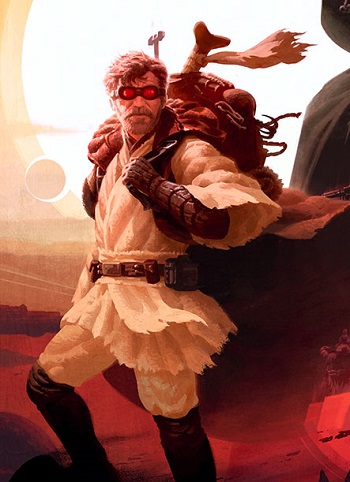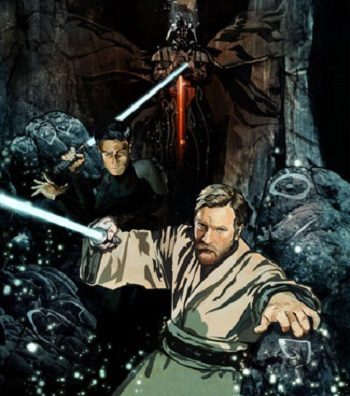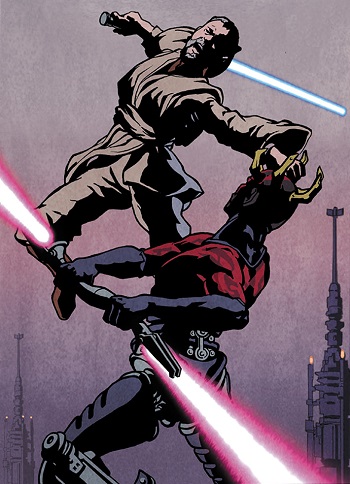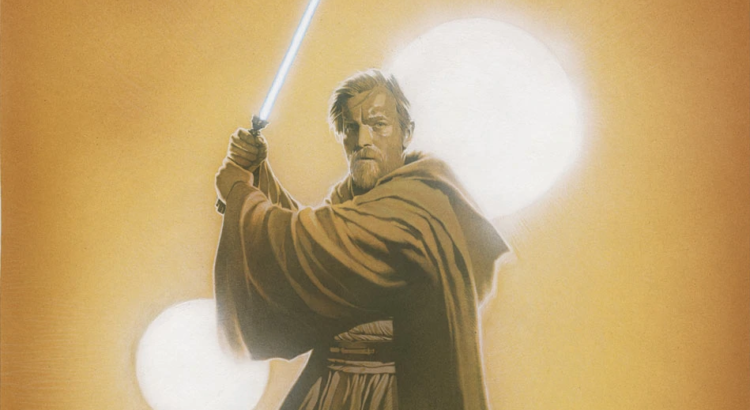“Years ago, we removed one child from Tatooine, thinking him to be the galaxy’s greatest hope. Now I have returned one—with the same goal in mind. I hope it goes better this time.” [1]From Kenobi, by John Jackson Miller
Well, here we are. After several years, countless rumors, and (if you believe those rumors) multiple false starts, Ewan McGregor is officially returning to the role of Obi-Wan Kenobi. What may or may not have once been planned as a spinoff film a la Solo: A Star Wars Story will instead be produced as a streaming series on the imminent Disney+ platform, meaning that this thinnest of concepts—guy sits in the desert for twenty years—will end up receiving at least as much screentime as an entire film trilogy put together.
But with that extra screentime comes different expectations. Without a hard two-to-three-hour time limit, streaming television can tell stories that film, perhaps Star Wars films in particular, just can’t; the stakes can be lower, the dangers more psychological, the character development more methodical. With a playground of two decades at their disposal, Lucasfilm can cherry-pick the most interesting thing (maybe the only interesting thing) that could possibly have happened to Obi-Wan during his exile and build a series around that, rather than try to tell an epic, multi-decade story just for the sake of filling a gap. With the timeline revealed at D23 placing the project around year eight of Obi-Wan’s nineteen-year desert vacation (during Solo‘s time jump, which may or not be important), it seems as if they do indeed plan on the former, which is music to my ears.
But even then, how much could really have happened to him? If Obi-Wan’s streaming exploits are too elaborate, too significant, doesn’t that undercut the whole idea of his exile? What if Luke gets trampled by a bantha while Obi-Wan is off fighting the Crimson Dawn?
Here is where we return to The Expanded Universe Explains, one of my longest-running projects here at Eleven-ThirtyEight. In this series I discuss how Legends-era storytelling approached certain questions and storytelling opportunities that continue to be relevant in the new canon—not as evidence of what will be the case, but as a guide for what could be. Which direction is the best, which answers make the most sense? I leave that for you to decide, dear readers.
27. What was Obi-Wan doing on Tatooine for all those years?
Our story begins, as EU stories often do, long before it actually begins. Decades prior to the rise of the Empire, likely several years before even The Phantom Menace, Ben Neluenf, a local podracing star with an annoying last name, attempted to scale the great mesa that lay at the center of what we know as the Boonta Eve Classic podrace circuit. I say “attemped” because he did not survive the experience—and thus, “Ben’s Mesa” was born.
Much, much later, after depositing a certain infant at a certain moisture farm, Obi-Wan sees the name on a map while visiting Tatooine’s quote-unquote capital Bestine and, recalling that it was a nickname he’d gone by in the past, decided to adopt it as his local name, insofar as one would be necessary.

It wasn’t long before Tatooine tested Obi-Wan’s willingness to remain a recluse. Within weeks, twenty moisture vaporators were stolen from the Lars farm by Tusken Raiders—a critical loss for the farm—and against Owen’s protests Obi-Wan set out to retrieve them himself. Reflecting on the Tuskens’ role in turning Anakin to the dark side (Padmé had told him about Shmi but not about Anakin’s response), Obi-Wan is tempted briefly by the dark himself in the eventual conflict before memories of Qui-Gon Jinn’s tutelage bring him back to lucidity, and instead of killing the Tuskens he shames them by cutting away their tents and coverings—exposure to the Tatooine sky means death and their taboos have evolved accordingly, and thus the fight is ended. This is not exactly the most empathetic handling of the Tuskens either in- or out-of-universe, but it does make for an interesting setup of later events.
Soon afterward (likely still within a couple months of his arrival) Obi-Wan rescues two locals, Annileen and Kallie Calwell, from a field of sarlaccs and is soon drawn into the politics of the nearby Pika Oasis. Annileen runs Dannar’s Claim, the commercial center of the oasis, and is involved with local farmer and entrepreneur Orrin Gault, who is attempting to organize the local settlers against the Tuskens and their periodic raids. Orrin is charismatic by Tatooine standards and popular in the Oasis, but he’s also deeply in debt to Jabba the Hutt, and the settler militia (not to mention his courting of Annileen) is more about his personal financial gain than any high-minded goals.
All of this would have been fine with Obi-Wan if he hadn’t gotten to know the Calwells, first by rescuing them and then through multiple supply runs to Dannar’s Claim. Escalating settler/Tusken hostilities could prove a danger to the region’s overall stability, and thus the Larses, so after failing to sway the settlers against Orrin’s leadership Obi-Wan joins forces with the local Tusken leader A’Yark, with whom he’s slowly developed a mutual respect. [2]Incidentally, A’Yark later featured in John Jackson Miller’s story “Rites” in A Certain Point of View, which also retconned her into one of the Tuskens who confront Luke in A … Continue reading As the conflict reaches its head and Orrin’s true motives are revealed, Obi-Wan is forced to reveal his own true nature to Orrin to save him from a Krayt dragon. Orrin plans to use this information as a final trump card but is rendered paraplegic in a speeder crash and taken in by A’Yark to live as a Tusken slave, his knowledge no longer of any use to him.
Two further casualties of these events are Obi-Wan’s last name, which he unwittingly speaks within earshot of Kallie (and thus “Ben Kenobi” is born) and Annileen’s friendship-but-maybe-more with Ben, as Obi-Wan through Bail Organa is able to secure her passage offworld and admission to a xenobiology curriculum on Alderaan, which is what she’d originally wanted to do with her life before her husband went and died and she got stuck tending store and raising kids. Never get married, folks.
Throughout all of this, mind you, Obi-Wan is meditating regularly to Qui-Gon but has not yet gotten a response of any kind. He’s also under the impression that Anakin is dead, which contributes in part to his feeling secure on Anakin’s home planet. That soon changes, when word of Darth Vader’s continued purging of the Jedi reaches a cantina Obi-Wan happens to be patronizing, along with an image of the armored monstrosity Anakin has become. Obi-Wan panic at this realization, suddenly reconsidering the whole plan, until at long last the voice of Qui-Gon comes to him and reassures him that he and Luke should stay where they are.

After about a year on Tatooine, Obi-Wan hears word of Jedi washout Ferus Olin leading a rebel uprising against the Empire on the planet Bellassa. While he’s been speaking with Qui-Gon for a while now, Qui-Gon maintains that Obi-Wan isn’t yet ready to learn how to transcend death—he does, however, suggest that leaving Tatooine to assist Ferus will further his own mission, so with Qui-Gon watching over Luke in his place (don’t think too hard about how that worked), Obi-Wan does just that.
Ferus and his allies are being pursued by Malorum, leader of the Imperial Inquisitorius. Malorum is a former intelligence agent who knows Darth Vader’s true identity, and wants to learn everything there is to know about Anakin Skywalker in the hopes of finding leverage to further his own rise in the ranks. Upon his reunion with Ferus Obi-Wan learns that Malorum has tasked Sancor, another Inquisitor, with investigating Padmé’s death on Polis Massa—and suddenly Obi-Wan’s relevance becomes clear.
While Ferus is occupied elsewhere Obi-Wan travels to Polis Massa and kills Sancor in that roundabout way good guys tend to kill people. Knowing that won’t stop Malorum for good, he charges Ferus with defeating him once and for all—explaining that it’s of the utmost importance but he can’t say why. With that, the book series is handed off to Ferus and Obi-Wan returns to Tatooine, where Qui-Gon tells him that he is now ready to learn all that cool immortality stuff despite the fact that he hadn’t done anything particularly challenging.
The following year Obi-Wan would meet another Jedi survivor, A’Sharad Hett. A’Sharad was a human who had been born to the Tuskens and upon the fall of the Jedi had returned to Tatooine to lead them. When his clans got too close to Lars territory Obi-Wan confronted them, once again failing to mention why a former Jedi Council member cared so much about this particular location. Obi-Wan sensed a new darkness in his former comrade and warned him to abandon the path of a Tusken war leader, but he wouldn’t listen. They dueled, and A’Sharad lost both an arm and his facial coverings, fleeing Tatooine in humiliation.

Another year later things got really nuts. In a story that technically wasn’t even part of Legends continuity, Darth Maul got himself a pair of robot legs and tracked Obi-Wan across the entire prequel trilogy before finding his way to the Lars homestead, threatening a three-year-old Luke’s life unless Obi-Wan showed himself. If you watched The Clone Wars and Star Wars Rebels this might seem familiar, but it actually predates Maul’s canon return by quite a while—in this franchise you just can’t keep a fun idea down.
Obi-Wan brutally defeats Maul but his killing blow is preempted by a head shot from the janky rifle of Owen Lars, who tells him to beat it as per usual. Obi-Wan retrieves the mangled corpse of his old enemy and departs.
After a busy few years, things finally settle down for good. At some point Obi-Wan investigates the possibility of a rescue mission to locate Outbound Flight, an exploratory mission he and Anakin had briefly been a part of years earlier, which had vanished in the Unknown Regions with several more Jedi on board. It’s just as well he didn’t go through with it because they were super dead.
Obi-Wan pops up a few more times during Luke’s teen years, saving him and his friends from a Krayt dragon, a sandstorm, and so on, but by now Luke is old enough to be the main character of these stories and Obi-Wan has become the weird hermit in the background. His days of consequence are over, at least until the fateful day when Luke shows up in the Jundland Wastes with a couple droids.
* * * * *
I want to break format here and highlight two specific sources from the above: the novel Kenobi by John Jackson Miller, dealing with the Calwell family, and the young-reader series The Last of the Jedi by Jude Watson, dealing with Ferus Olin. The central question, I think, of an Obi-Wan project in this time period is: does he leave Tatooine or not? If he does, then you have all sorts of possibilities, as Watson’s story illustrates—the stakes can be higher, up to and including the direct attention of Vader and Palpatine themselves. Once he’s off Tatooine you can pretty much jump from planet to planet as you see fit, and as long as he’s not waving his lightsaber around in any city centers you can do something that very much feels like what the average person would expect from a Star Wars story.
If he stays on Tatooine, you have somewhat fewer options. He can’t overthrow the Hutts and bring democracy to the moisture farmers; he can’t even do much for the Lars family beyond keeping them alive. The stakes have to remain local—settlers versus Tuskens, say—because galactic stakes bring galactic consequences, and if the Emperor so much as glances in that direction the jig is up.
But as I said at the top, television and movies have different strengths. A story set on Tatooine can really dig into Tatooine in a way a movie can’t. The stakes don’t need to be huge because you have time to really get to know the characters and learn to care about their problems, however trivial they might seem compared to Obi-Wan’s mission. Why tackle this premise just to undo everything that makes it unique, in the name of feeling more “Star Wars-y”? This was my immediate complaint about Solo, actually; it tried too much to feel like a regular Star Wars movie despite the actual events not being all that consequential, and instead came across like a low-key imitation instead of its own thing. We may never know for sure whether the Obi-Wan project was meant to be a film at one point but I’m very, very glad that television is what we ended up with. I hope they just let it be that.
Further reading:
- “The Last One Standing”
- Kenobi
- Dark Lord: The Rise of Darth Vader
- The Last of the Jedi: The Desperate Mission
- The Last of the Jedi: Dark Warning
- Legacy Vol. 3: Claws of the Dragon
- “Old Wounds”, Star Wars: Visionaries
- Tatooine Ghost
- Adventure in Beggar’s Canyon
| ↑1 | From Kenobi, by John Jackson Miller |
|---|---|
| ↑2 | Incidentally, A’Yark later featured in John Jackson Miller’s story “Rites” in A Certain Point of View, which also retconned her into one of the Tuskens who confront Luke in A New Hope, making her the one element of this story that’s still somewhat canon. |


Totally agree with your analysis of the storytelling options between a movie and a TV series; I’ve been saying for a long time I would rather have an Obi-Wan series. I’m stoked that with D+ now, there’s a business case for making longer-form live-action SW stories. I would hate for the “Obi-Wan in the desert” story to become a planet-hopping tale just because there’s a need for sizzle shots in a trailer and a play for the Chinese theatrical market.